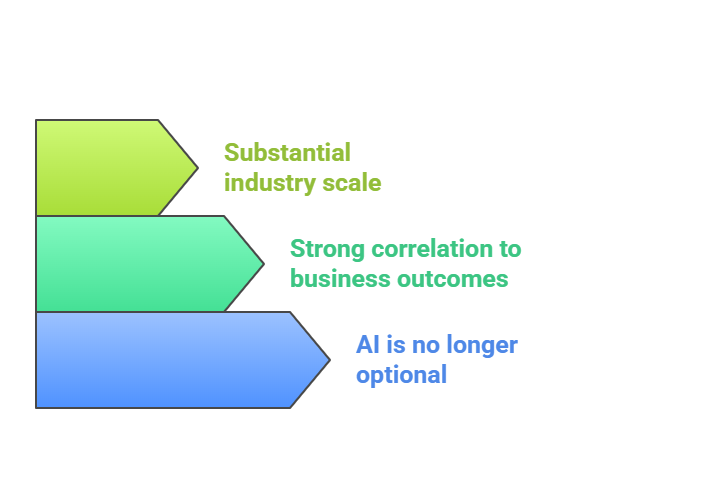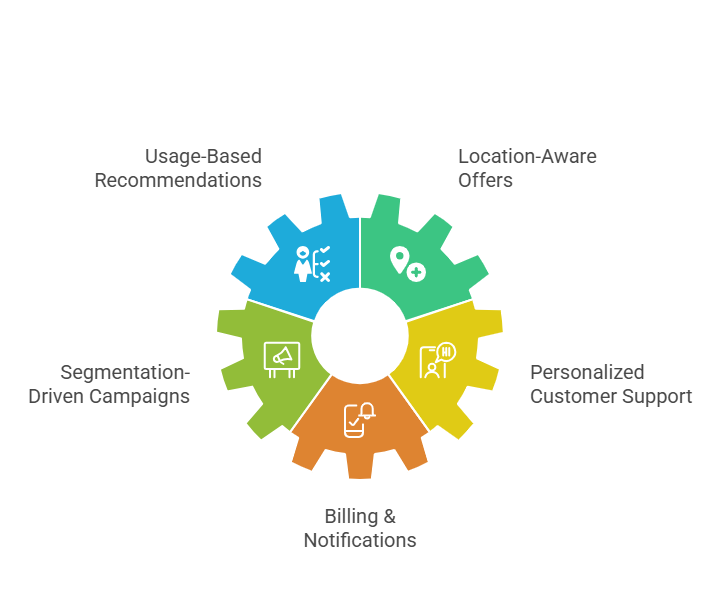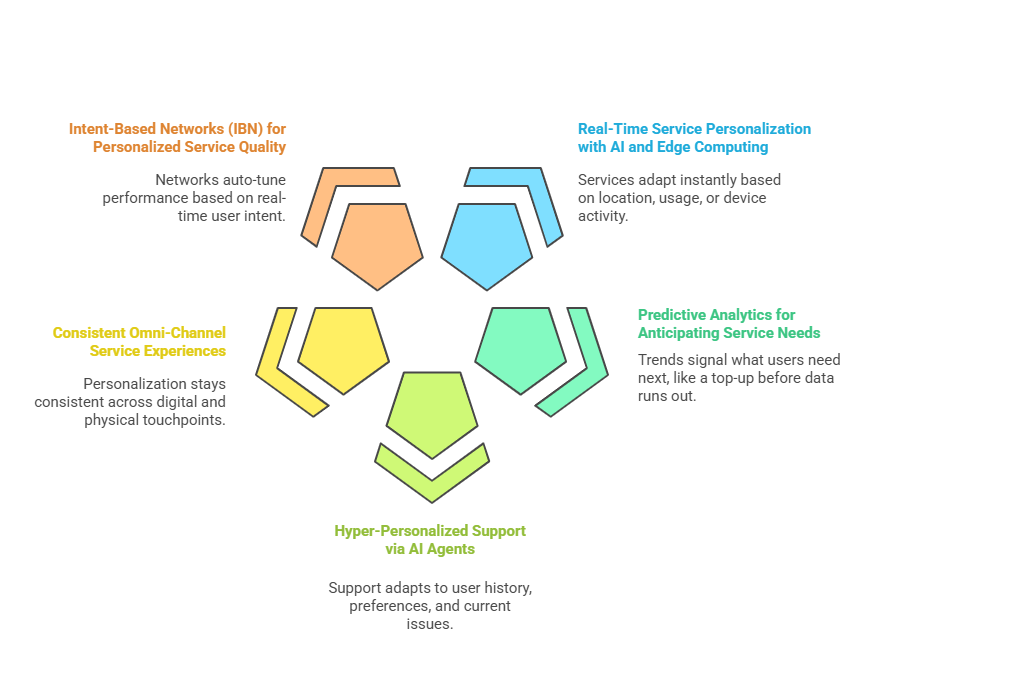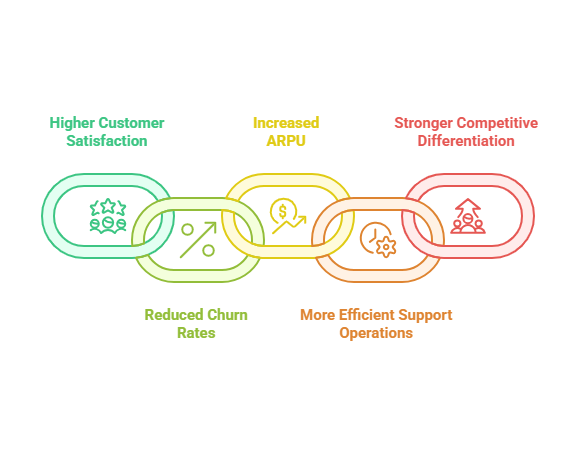For years, telecom success was measured in coverage, speed, and cost efficiency. But as networks mature and digital habits evolve, those benchmarks are no longer enough. Today’s competitive edge lies in how well operators understand and adapt to the individual needs of each customer, not just through marketing, but at the service level itself.
Leading telecoms are no longer positioning themselves as just providers of connectivity; they’re becoming experience enablers. From usage-based offers to real-time support, service personalization in telecom is emerging as a key lever for growth. A recent report notes: “65% of telecom companies report using AI to improve customer experience.”
But the real shift goes deeper. Personalization is evolving from campaign-level targeting to AI-powered telecom services that are intent-aware, responsive, and proactive. These systems can anticipate needs, optimize network performance, and enable faster, more contextual support. The result? Higher engagement, lower churn, and smarter monetization.
In this blog, we explore how AI in telecom, combined with automation and customer experience in telecom, is transforming the way operators design, deliver, and differentiate their services creating value for both users and the business.
Telecom Industry Context
The telecom landscape is undergoing a profound transformation, driven by AI, 5G, and evolving customer expectations. A compelling insight from BCG’s 2024 Telecommunications Value Creators Report illustrates the pivotal role of AI across the industry:
“The AI revolution is underway, transforming the telecommunications, media, and technology sectors.”
This observation is backed by the sector’s trajectory in shareholder returns, a clear signal that strategic investments in AI and modern network architecture are delivering tangible value:
- Before AI: From 2019 to 2023, telecoms delivered a median annualized total shareholder return (TSR) of just 6%, lagging behind the broader market.
- With AI Focus: Telcos actively deploying AI and next-gen infrastructure demonstrated significantly stronger value creation, informed by BCG’s analysis of top-performing operators.
What this tells us,

- AI is no longer optional: Leading operators are now leveraging advanced AI to optimize operations, drive customer engagement, and shape strategic transformation.
- Strong correlation to business outcomes: Investment in AI and next-gen tech directly aligns with improved TSR and competitiveness.
- Substantial industry scale: With enormous network infrastructure and subscriber bases, telcos are uniquely positioned to scale personalized, AI-powered services effectively.
What Personalization in Telecom Looks Like Today
Telecom providers have made strong progress toward personalization, but many current efforts remain rule-based, fragmented, and reactive. Most systems are designed to respond after the fact, rather than proactively adapting in real time. Still, these early steps are reshaping the customer experience in telecom paving the way for smarter, more adaptive engagement.
Here are some of the key ways personalization is being implemented today:
Key Forms of Personalization in Use Today,

- Usage-Based Recommendations
Plans and offers are tailored based on individual usage patterns, device preferences, and historical behavior—laying the groundwork for more personalized telecom experiences. - Location-Aware Offers
Promotions are triggered by user location, such as activating roaming packs when a customer travels, or pushing relevant offers near retail outlets. - Segmentation-Driven Campaigns
Customers are grouped by demographics, ARPU, or churn risk to deliver customized marketing messages. While common, this approach often lacks the dynamic intelligence of true AI-powered telecom services. - Personalized Customer Support
Support platforms recognize repeat users, retrieve interaction history, and deliver faster resolutions improving both efficiency and customer experience in telecom environments. - Billing & Notifications
Alerts and messages are personalized to user preferences, billing cycles, and thresholds ensuring that communication remains relevant and timely.
While these strategies improve customer engagement, they remain mostly static and disconnected. The next evolution lies in predictive, real-time, and AI-powered personalization, and that’s exactly where the industry is headed.
The Future of Service Personalization in Telecom
As telecom operators reimagine their service delivery models, the focus is shifting from one-size-fits-all offerings to intelligent, adaptive service personalization driven by AI in telecom, edge computing, and unified data intelligence. These capabilities go beyond marketing customization and directly shape how services are delivered, supported, and experienced by each individual user.

Real-Time Service Personalization with AI and Edge Computing
AI models deployed at the edge enable AI-powered telecom services to instantly tailor service delivery adjusting data speeds, content delivery, or real-time offers based on actual usage. Whether it’s boosting bandwidth during a video call or enabling location-based services, these are personalized telecom experiences in action.
Predictive Analytics for Anticipating Service Needs
Operators are now moving from reactive to proactive service. By using AI in telecom to anticipate actions like identifying when a user may soon run out of data and prompting a top-up telecoms improve continuity and strengthen the customer experience in telecom.
Hyper-Personalized Support via AI Agents
Support journeys are evolving with AI-powered telecom services that understand customer history and behavior. Virtual agents reduce friction and resolve issues faster providing support that feels truly personal and aligned with user context.
Consistent Omni-Channel Service Experiences
Today’s users expect seamless transitions across touchpoints. Unified telecom customer data platforms help maintain personalization across apps, chat, voice, and retail ensuring consistent telecom customer engagement no matter where the interaction starts or ends.
Intent-Based Networks (IBN) for Personalized Service Quality
Networks are becoming context-aware. With AI in telecom infrastructure, systems can detect user intent streaming, gaming, video calling and dynamically optimize performance for that activity. These intelligent adjustments bring personalized telecom experiences to the network layer itself.
These innovations point to a future where telecoms deliver not just services, but smart, adaptive experiences. By investing in telecom customer data platforms, AI-powered telecom services, and real-time intelligence, operators can unlock deeper telecom customer engagement while reshaping the very nature of the customer experience in telecom.
Technologies Enabling the Future
The future of service personalization in telecom is being powered by a modern, AI-driven technology stack. Artificial intelligence and machine learning allow operators to analyze user behavior, network activity, and support interactions to deliver context-aware services in real time.
Edge computing enhances this by processing data closer to the user, enabling ultra-low-latency personalization, such as dynamic bandwidth allocation or location-aware service delivery.
Supporting this shift are digital BSS platforms and unified Customer Data Platforms (CDPs), which make it possible to configure services on the fly and maintain a 360-degree view of each customer across all touchpoints.
Generative AI is transforming support experiences through intelligent virtual agents, while microservices architecture and open APIs ensure seamless integration of personalization engines and rapid deployment of new features.
Together, these technologies are helping telecoms move from transactional service providers to adaptive, customer-centric platforms.
Benefits of Service Personalization in Telecom
Personalized services are no longer just a customer expectation; they’re a business growth lever. Telecom operators that embed personalization into service delivery see tangible gains across experience, efficiency, and profitability.

- Higher Customer Satisfaction: Relevant, timely, and proactive services create stronger engagement and loyalty.
- Reduced Churn Rates: Personalized interactions make customers feel understood and valued, lowering the likelihood of switching.
- Increased ARPU (Average Revenue Per User): Targeted upgrades and cross-sell opportunities based on real usage patterns drive revenue growth.
- More Efficient Support Operations: AI-driven personalization reduces repetitive queries, shortens resolution times, and cuts service costs.
- Stronger Competitive Differentiation: Personalized experiences set brands apart in a commoditized market.
In a saturated and price-sensitive industry, service personalization helps telecoms retain relevance, improve margins, and build lasting customer relationships.
Challenges to Solve for Scalable Service Personalization
As telecom operators scale their personalization efforts, some foundational areas require thoughtful transformation to fully realize the vision of intelligent, adaptive service delivery.
One key focus area is data unification. With information distributed across multiple systems billing, CRM, support, and network operations, bringing these sources together into a cohesive customer view is essential for personalization to work consistently across touchpoints.
Another important consideration is the need for real-time responsiveness. As AI-driven models become more prevalent, telecoms are investing in infrastructure and processing capabilities that support low-latency decision-making at scale.
There’s also growing attention on governance and customer trust. As personalization deepens, ensuring transparent data practices, clear consent mechanisms, and compliance with evolving privacy regulations becomes even more critical.
Additionally, personalization design itself is evolving. The goal is to create experiences that are not only relevant but also respectful of user intent and attention, avoiding over-personalization and ensuring the right balance of automation and human touch.
By focusing on these enablers, telecom leaders are building the groundwork for personalization strategies that are not only effective but also scalable, secure, and customer-centric.
Conclusion
The telecom industry is entering a new era, where service personalization isn’t just a value-add, but a strategic imperative. As AI, edge computing, and unified data platforms mature, telecom operators have a unique opportunity to reimagine how services are delivered, supported, and experienced.
By embedding intelligence into every interaction, personalization becomes more than marketing; it becomes a differentiator, a loyalty driver, and a foundation for long-term innovation. Operators can move from reacting to customer needs to anticipating them, from static offerings to adaptive service delivery.
This is no longer a future vision; it’s already underway. And the telecoms that lead with personalization will set the standard for customer-centric, digitally agile networks in the years to come.
Telecom leaders should take a closer look at where service personalization fits into their growth and customer experience roadmap. The right use cases, powered by the right technology, can unlock measurable value faster than expected.
Now is the time to lead not just in connectivity, but in how intelligently that connection is personalized.
